Code completion
This section covers various techniques of context-aware code completion that allow you to speed up your coding process.
Basic completion
Basic code completion helps you complete the names of classes, methods, and keywords within the visibility scope. When you invoke code completion, RubyMine analyses the context and suggests the choices that are reachable from the current caret position (suggestions also include Live templates).
Invoke basic completion
Start typing a name.
Press Ctrl+Space or choose from the main menu.

If necessary, press Ctrl+Space for the second time (or press Ctrl+Alt+Space).
The completion popup shows all declared names. In this case, RubyMine suggests text-based results regardless of whether they are appropriate in the current context.
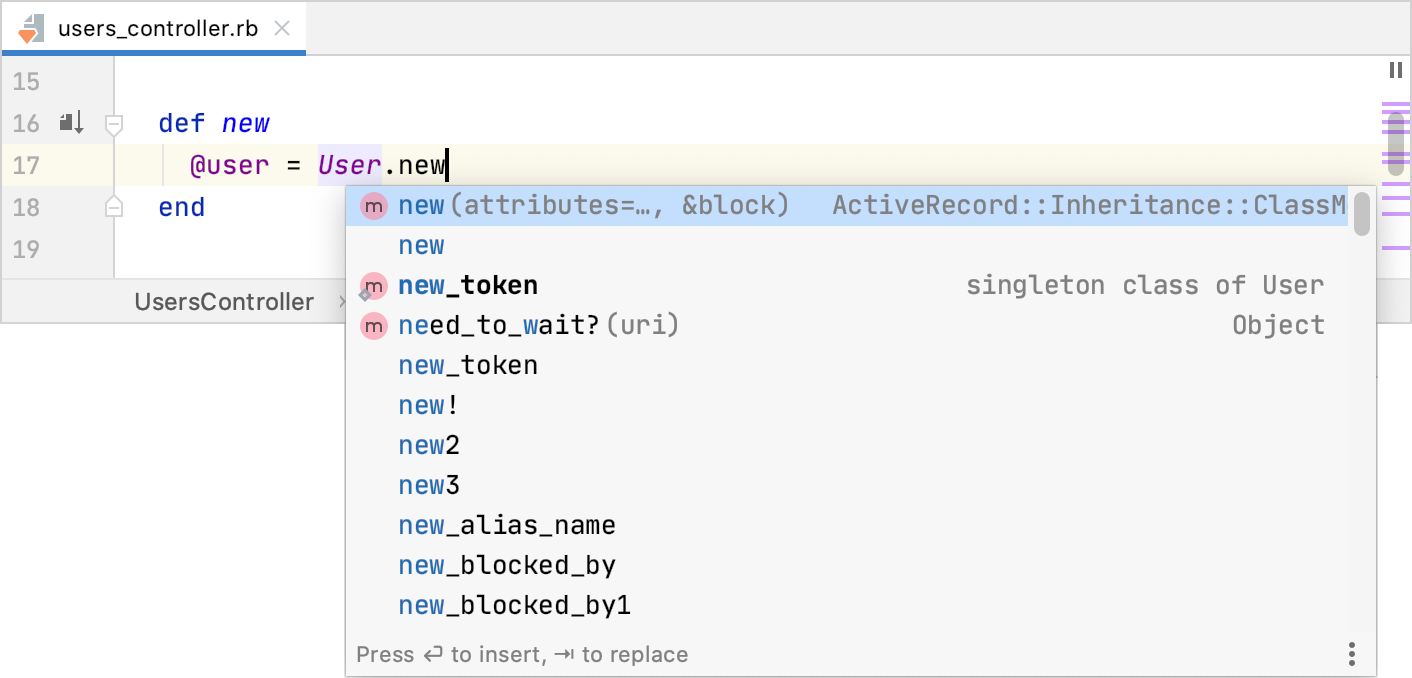
Hippie completion
Hippie completion is a completion engine that analyses your text in the visible scope and generates suggestions from the current context. It helps you complete any word from any of the currently opened files.
Expand a string at caret to an existing word
Type the initial string and do one of the following:
Press Alt+/ or choose to search for matching words before the caret.
Press Alt+Shift+/ or choose to search for matching words after the caret and in other open files.
The first suggested value appears, and the prototype is highlighted in the source code.

Accept the suggestion, or hold the Alt key and keep pressing / until the desired word is found.
Postfix code completion
Postfix code completion helps you reduce backward caret jumps as you write code. You can transform an already-typed expression to a different one based on a postfix you type after the dot, the type of expression, and its context.
Enable and configure postfix completion
Go to Settings / Preferences | Editor | General | Postfix Completion and select the Enable postfix completion checkbox.
Select Tab, Space, or Enter to be used for expanding postfix templates.
Enable/disable a particular postfix template for the selected language.
Transform a statement with a postfix
Type an expression and then type a postfix after a dot, for example,
.if:
(Optional step) If required, select an expression that will be used as a condition:

Press Enter:

You can disable certain postfix completion templates in the Editor | General | Postfix Completion page of the IDE settings Ctrl+Alt+S.
You can select Tab, Space, or Enter to expand postfix templates.
You can edit the predefined postfix templates, for example, to replace a long key with a shorter one, or to expand the list of applicable expression types.
Create custom postfix templates
Press Ctrl+Alt+S to open IDE settings and select Editor | General | Postfix Completion.
Click the Add button (
) on the toolbar.
Specify the Key that is the combination of symbols that will invoke the template. Select which expression types the new template will be applicable to, and type the target expression in the following format:
$EXPR$ <target_expression>, for example,$EXPR$ =!null.
Completion of tags and attributes
RubyMine automatically completes names and values of tags and attributes in many file types:
HTML/XHTML, including completion for CSS classes and for HTML tags inside JSX.
XML/XSL, including completion for namespaces.
JSON, see Editing package.json for details.
Complete tag names
Press < and start typing the tag name. RubyMine displays the list of tag names appropriate in the current context.

Use the Up and Down buttons to scroll through the list.
Press Enter to accept a selection from the list. If your file is associated with a schema or a DTD, RubyMine automatically inserts the mandatory attributes according to it.
Import a taglib declaration
If you need to use tags declared in a tag library, you need to import this taglib before any custom tag from it can be used.
Start typing a taglib prefix and press Alt+Insert.
Select a taglib from the list and press Enter.

RubyMine imports the selected taglib and adds the import statement automatically.
Insert a tag declared in a taglib
Start typing a tag and press Ctrl+Alt+Space.
Select a tag from the list. The
uriof the taglib it belongs to is displayed in brackets.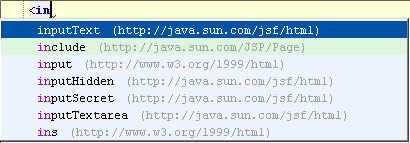
Select the desired taglib and press Enter. RubyMine adds the declaration of the selected taglib:

Configure code completion settings
To configure code completion options, go to the Editor | General | Code Completion page of the IDE settings Ctrl+Alt+S.
You can choose the following settings:
Item | Description |
|---|---|
| Match case | Select if you want letter case to be taken into account for completion suggestions. Choose whether you want to match case for the first letter or for all letters. |
| Automatically insert single suggestions for | Select if you want to automatically complete code if there's just one suggestion for basic and/or smart type-matching completion. |
| Sort suggestions alphabetically | Select if you want to sort items in the suggestions list in the alphabetical order instead of sorting them by relevance. You can change this behavior at any time by clicking |
| Show suggestions as you type | Select if you want the suggestions list to be invoked automatically, without having to call completion explicitly. This option is enabled by default. |
| Insert selected suggestion by pressing space, dot, or other context-dependent keys | Select if you want to insert the selected suggestion by typing certain keys that depend on the language, your context, and so on. |
| Show the documentation popup in | Select to automatically show a popup for each item in the suggestions list with the documentation for the class, method, or field currently highlighted in the lookup list. In the field to the right, specify the delay (in milliseconds), after which the popup should appear. |
| Preselect first completion element | Choose this option if you want to preselect the first item in the suggestions list. |
Completion tips and tricks
Narrow down the suggestions list
You can narrow down the suggestions list by typing any part of a word (even characters from somewhere in the middle) or invoking code completion after a dot separator. RubyMine will show suggestions that include the characters you've entered in any positions.
This makes the use of wildcards unnecessary:

In case of CamelCase or snake_case names, type the initial letters only. RubyMine automatically recognizes and matches the initial letters.

Accept a suggestion
You can accept a suggestion from the list in one of the following ways:
Press Enter or double-click a list item to insert it to the left of the caret.
Press Tab to replace the characters to the right from the caret.
Use Ctrl+Shift+Enter to make the current code construct syntactically correct (balance parentheses, add missing braces and semicolons, and so on).
You can also use specific keys to insert the selected completion suggestion: go to the Editor | General | Code Completion page of the IDE settings Ctrl+Alt+S and select the Insert selected suggestion by pressing space, dot, or other context-dependent keys option. These keys depend on the language, your context, and so on.
View reference
You can use the Definitions by pressing Ctrl+Shift+I when you select an entry in the suggestions list:
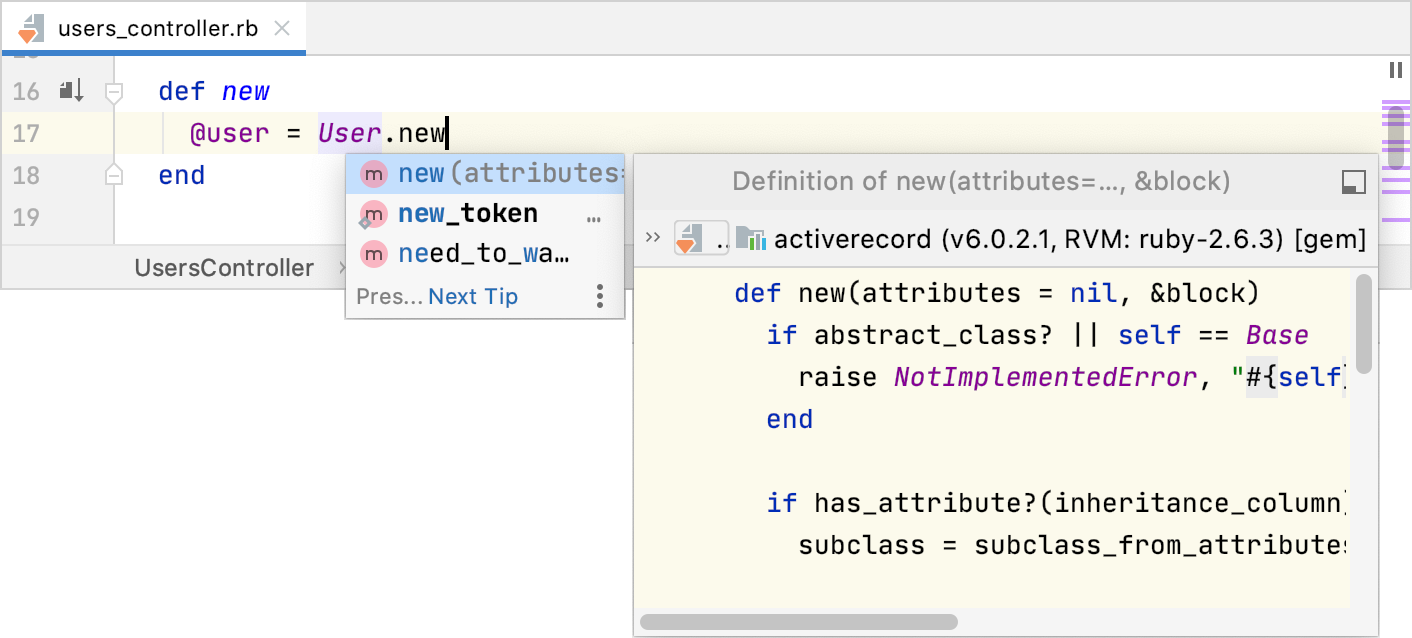
You can use the Quick Information view by pressing Ctrl+Q when you select an entry in the suggestions list:
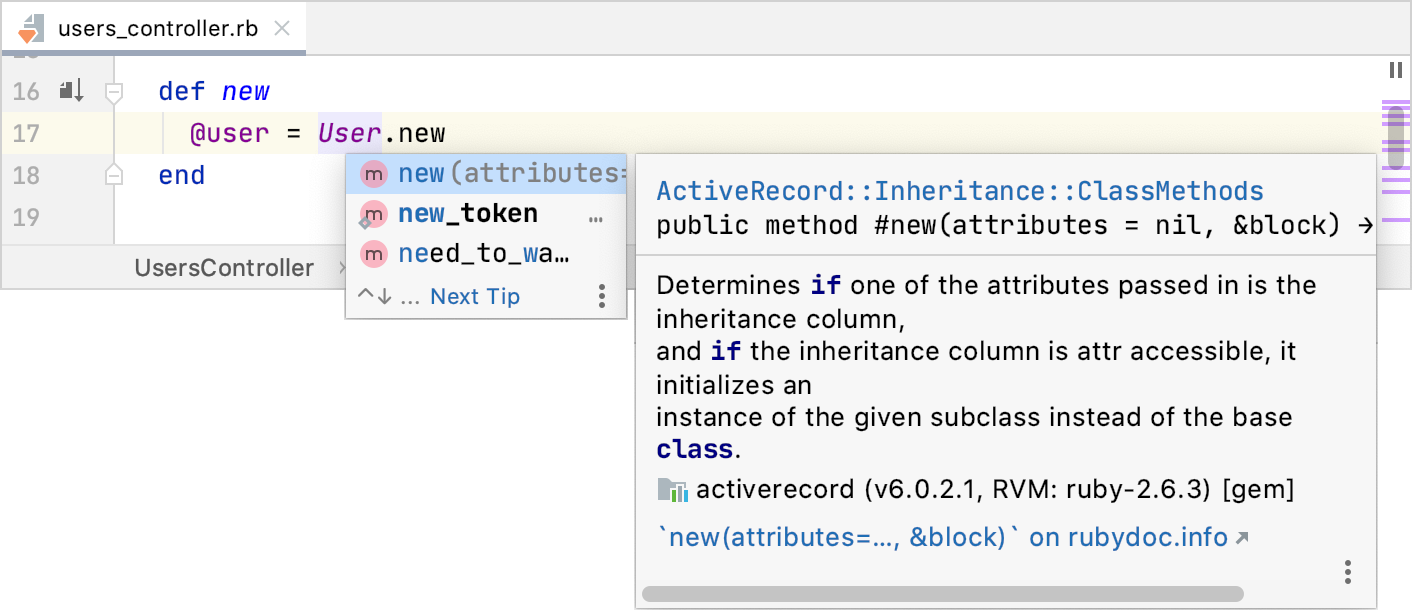
View code hierarchy
You can view code hierarchy when you've selected an entry from the suggestions list:
Ctrl+H- view type hierarchy
Ctrl+Shift+H- view method hierarchy.
Use machine-learning-assisted code completion
You can utilize machine learning models to rank most suitable items higher in the suggestions list.
To do this, go to
Press Ctrl+Alt+S to open IDE settings and select Editor | General | Code Completion.
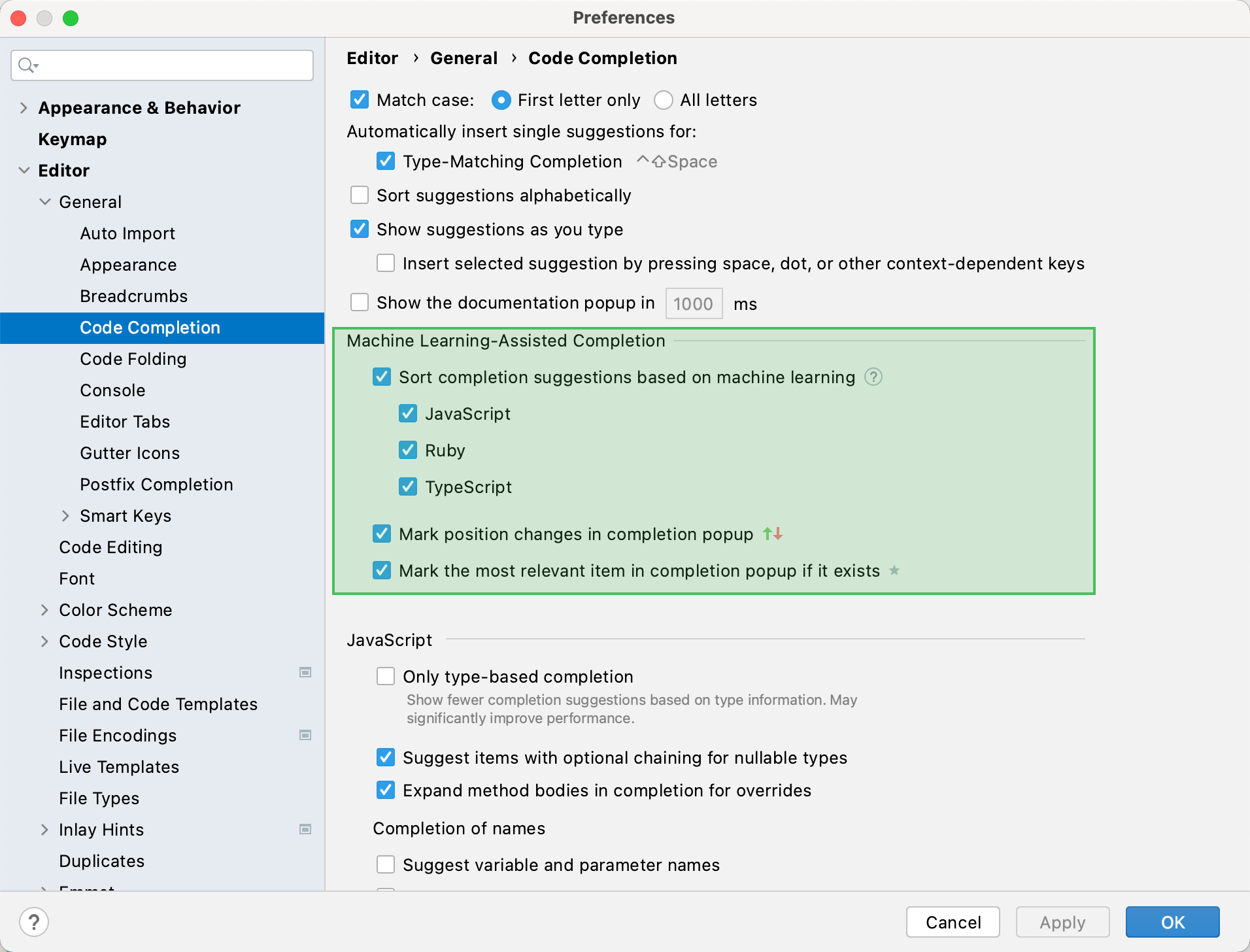
The and
arrow icons indicate whether the relevance of a suggestion is increasing or decreasing and therefore the suggestion has moved up or down the list. The
icon indicates the most suitable suggestion.
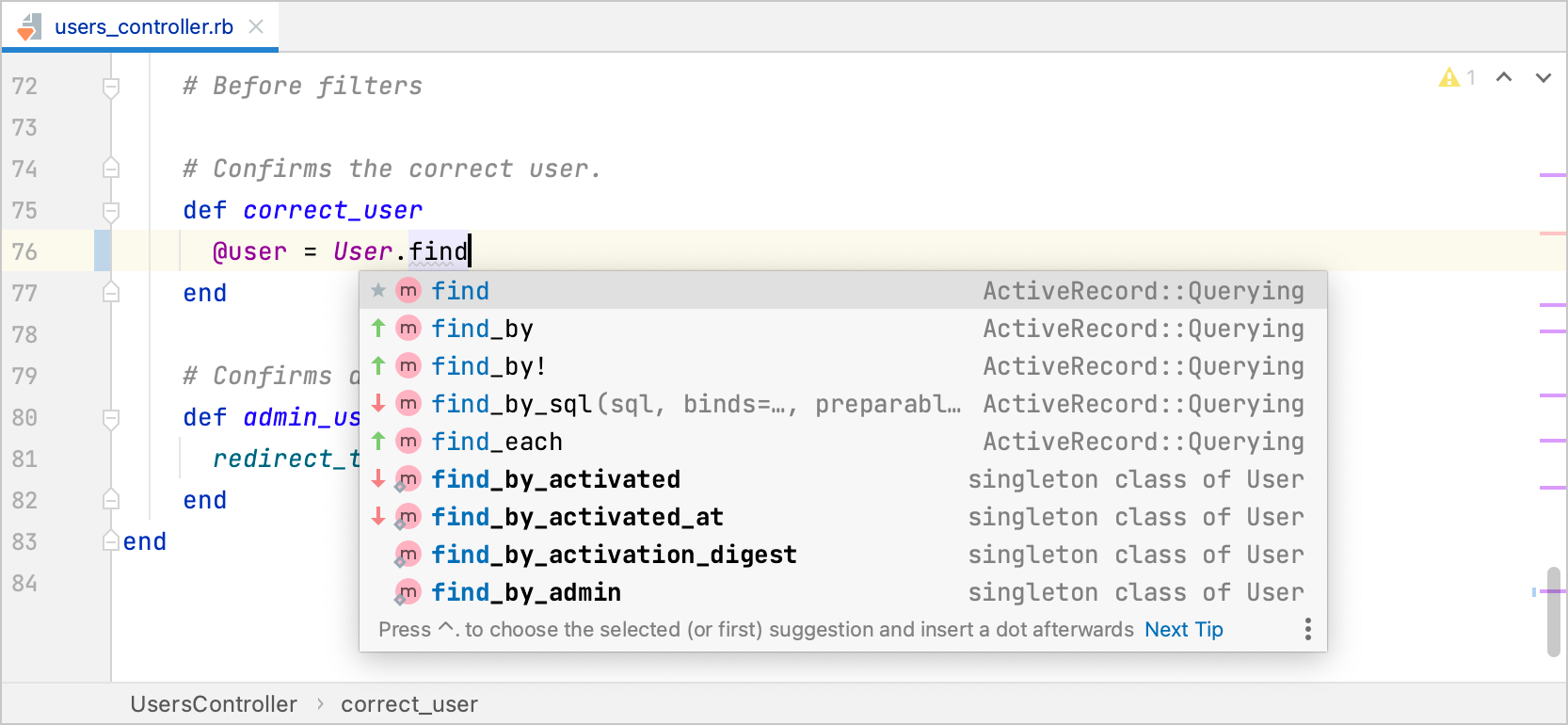
Troubleshooting
If code completion doesn't work, this may be due to one of the following reasons:
The Power Save Mode is on (File | Power Save Mode). Turning it on minimizes power consumption of your laptop by eliminating the background operations, including error highlighting, on-the-fly inspections, and code completion.
An SDK is not configured for your project.
Your file doesn't reside in a content root, so it doesn't get the required class definitions and resources needed for code completion.
A file containing classes and functions that you want to appear in completion suggestions list is marked as a plain text file.
External libraries that contain functions that you want to appear in the completion suggestions list are not added as dependencies or global libraries.